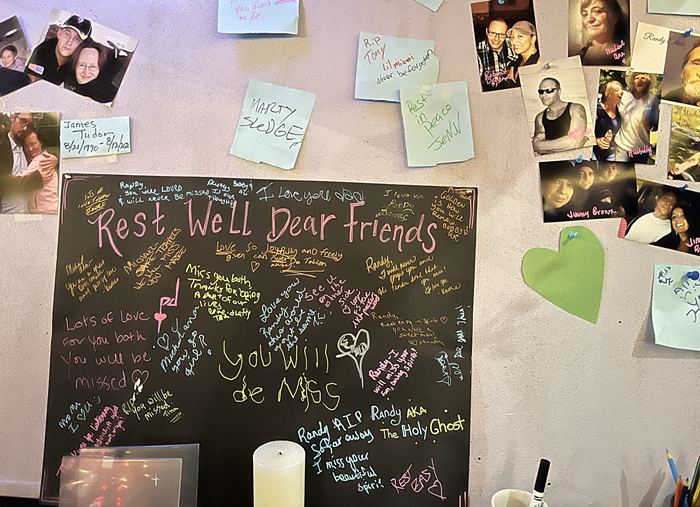
- Matt Stangel
- Gary A. Freitas' "Singularity"
In its inaugural showing, the People's Biennial is a bi-yearly exhibition formed by curators Jens Hoffman and Harrell Fletcher as a response to "the art world's ever-increasing exclusivity." Attempting to offset this exclusivity, the exhibit includes artists from cities outside mainstream art hubs— Portland; Scottsdale, AZ; Rapid City, SD; Winston-Salem, NC; and Haverford, PA. On view at Washington High School through October 17 (and afterward, traveling between the aforementioned cities), the offerings range from homemade science videos (Warren Hatch) to slice-of-life photography (Jorge Figueroa), mutant piñatas (Beatrice Moore) to super-rad sculptures made of old computer chips (Gary A. Freitas). The artists are largely self-taught or MFA-less, and together create an easily digestible pocket in this year's TBA programming.
After the jump are some personal highlights, as well as thoughts on the inclusion of the People's Biennial in TBA:10.

- Independent Curators International
- Robert Smith Shabazz shows his work
As I mentioned above, there's a wide range of work presented in the People's Biennial. Some of it is playful, like local artist Dennis Newell's Lego exhibit. Pitting plastic Star Wars characters against one another, Newell says he's exploring how to render "one's own ideas from a suggested pattern"— creating X-Wings and other vehicles with loose Lego pieces, rather than the pre-fab, collectible kits. A similarly light offering, Caleb Belden's (SD) portraits and animations of Metallica, Cannibal Corpse, and characters from 300 are executed with a Beavis and Butt-head aesthetic. But other exhibits are less playful, like Robert Smith Shabazz's (PA) portraits of African American icons, including paintings of Martin Luther King, Tupac, Elijah Muhamed, Miles Davis, and the Obama family. And there are plenty of other serious projects worth checking out.

- Matt Stangel
- Gary A. Freitas' "Singularity"
One such offering is Gary A. Freitas' (AZ) "Singularity," a series of sculptures made from computer chips, combining relevant post-humanist insights with a strong visual appeal. Shaped like flowers or mandalas, these sculptures are intended to comment on the confluence of creativity and technology, humanity and digital consciousness. In being equally suggestive of organic life and religious symbolism, Freitas' sculptures do a good job representing humanity's near-spiritual reverence for technology, as well as the theoretical projections of our increasingly entwined relationship with digital devices. (For those who are unfamiliar, "singularity" is a technological theory stating that if we create smarter-than-human intelligence, it will become harder to maintain control over future technologies and our relationship with them.)

- Independent Curators International
- Raymond Mariani's "Conducting"
The show also includes artwork created as a mode of therapy. Take Raymond Mariani's (NC) illustrative self-portraits as an example. Mariani, a 26-year-old living with autism, has used art to cope with "severely limited verbal communication abilities" throughout his life. His self-portraits, unified by the low facial muscle definition common to people affected with autism, show Mariani as a magician, logger, conductor, dentist, fireman, bus driver, etc.. Mariani's illustrations offer a somewhat heart-wrenching glimpse into one person's coping mechanisms, escaping from bodily limitations, over and over again, by imagining himself into various professions.

- Matt Stangel
- Installation by Sylvia Gray and the Elsewhere Collaborative
Still, other offerings are community or service oriented. Local artist Ally Drozd curated a presentation of works created by criminal offenders under an art program implemented by Judge Evans of the Portland Community Court: "The artwork," Drozd writes, "displayed in the court for a year, counts as [an offender's] service to the community, earning them a dismissal or a sentence of discharge in their case." The works are illustrative, ranging from cartoon characters to courtroom scenes. Also servicing the community, the Elsewhere Collaborative (NC) pays homage to Sylvia Gray and the legacy of objects she left behind. From the artist statement: "Gray created a series of businesses in downtown Greensboro, NC: a used furniture resale store; a national army surplus catalog company; a fabric outlet; and a vintage clothing store. The series culminated in a three-story thrift store, an installation of mountainously heaped cultural artifacts. Discovered in its final form in 2003, having sat undisturbed for six years after Gray's passing in 1997, this vast puzzle has fueled the re-arrangement of histories and artifacts..." A small chunk of the collection (pictured above) is on display.

- PICA
- JJ Ross' "Venom"
Though even with this wide range of work, when I bring up the People's Biennial with artists and friends, they often give it the "slow kid made a birdhouse" treatment. "Oh yeah, it's nice," they say, and that's about as far as most are willing to comment. When pressed, one artist said, "it looks like a lot of stuff made by kids, or stuff that's supposed to look like it was made by kids." Yep. There are quite a few pieces in the show that are heavy on the "my kid could've done that" factor, and, yes, some of the artists are in fact children, like JJ Ross, who draws superheroes and family members. Yet, these observations probably miss the point. Much of the work in the show comes from a service or therapy angle— made not for competition in the contemporary art world, but for the improvement of its maker or their community.
In the end, the People's Biennial recounts some interesting stories that could have otherwise gone unheard, and for me, that's reason enough to go check things out. Additionally, the show goes where no TBA has gone before— into the realm of the purely accessible. It's a refreshing exhibit, especially after a ten-day, PICA-caliber, art bender. So if you find yourself at Washington High School getting worn out by the more challenging exhibits, take a peek at the People's Biennial; you'll probably find something to like.












